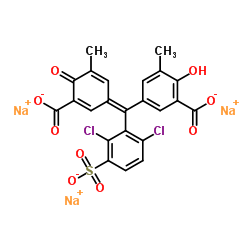Alberon

Alberon structure
|
Common Name | Alberon | ||
|---|---|---|---|---|
| CAS Number | 1667-99-8 | Molecular Weight | 605.28400 | |
| Density | N/A | Boiling Point | N/A | |
| Molecular Formula | C23H13Cl2Na3O9S | Melting Point | N/A | |
| MSDS | Chinese USA | Flash Point | N/A | |
|
Halloysite nanotubule clay for efficient water purification.
J. Colloid. Interface Sci. 406 , 121-9, (2013) Halloysite clay has chemical structure similar to kaolinite but it is rolled in tubes with diameter of 50 nm and length of ca. 1000 nm. Halloysite exhibits higher adsorption capacity for both cationic and anionic dyes because it has negative SiO2 outermost an... |
|
|
Predicting the composition of red wine blends using an array of multicomponent Peptide-based sensors.
Molecules 20 , 9170-82, (2015) Differential sensing using synthetic receptors as mimics of the mammalian senses of taste and smell is a powerful approach for the analysis of complex mixtures. Herein, we report on the effectiveness of a cross-reactive, supramolecular, peptide-based sensing ... |
|
|
Metachelins, mannosylated and N-oxidized coprogen-type siderophores from Metarhizium robertsii.
J. Nat. Prod. 77(7) , 1685-92, (2014) Under iron-depleted culture conditions, the entomopathogenic fungus Metarhizium robertsii (Bischoff, Humber, and Rehner) (= M. anisopliae) produces a complex of extracellular siderophores including novel O-glycosylated and N-oxidized coprogen-type compounds a... |
|
|
Using enantioselective indicator displacement assays to determine the enantiomeric excess of alpha-amino acids.
J. Am. Chem. Soc. 130(37) , 12318-27, (2008) Enantioselective indicator displacement assays (eIDAs) were used for the determination of enantiomeric excess (ee) of alpha-amino acids as an alternative to the labor-intensive technique of chromatography. In this study, eIDAs were implemented by the use of t... |
|
|
Characterization of disposable optical sensors for heavy metal determination
Talanta 94 , 123-32, (2012) Highlights ► Disposable optical sensors for determination of zinc, copper, nickel, iron(II), and iron(III). ► Simultaneous determination of heavy metals by combining optical sensors with chemometric multicomponent analysis. ► An efficient and inexpensive alte... |
|
|
Virulence factors and pathogenicity of Hafnia alvei for gilthead seabream, Sparus aurata L.
J. Fish Dis. 28(7) , 411-7, (2005) Virulence factors (eae gene, haemolytic capacity, fimbriae, resistance to the bactericidal effect of serum, siderophore production) and pathogenicity for gilthead seabream, Sparus aurata L., were analysed for 23 Hafnia alvei strains. None of the strains used ... |
|
|
Identification and analysis of a siderophore biosynthetic gene cluster from Agrobacterium tumefaciens C58.
Microbiology 150(Pt 11) , 3857-66, (2004) Using the complete genome sequence from Agrobacterium tumefaciens C58, the authors identified a secondary metabolite gene cluster that encodes the biosynthesis of a metabolite with siderophore activity. Support for this conclusion came from genetic and regula... |
|
|
Identification of erythrobactin, a hydroxamate-type siderophore produced by Saccharopolyspora erythraea.
Lett. Appl. Microbiol. 42(4) , 375-80, (2006) To investigate the production of siderophores by Saccharopolyspora erythraea SGT2 and how this production is affected by the inoculum.When grown in a low-iron, chemically defined medium (CDM), the soil dwelling actinomycete S. erythraea secretes a substance t... |
|
|
Cytochrome c4 is required for siderophore expression by Legionella pneumophila, whereas cytochromes c1 and c5 promote intracellular infection.
Microbiology 157(Pt 3) , 868-78, (2011) A panel of cytochrome c maturation (ccm) mutants of Legionella pneumophila displayed a loss of siderophore (legiobactin) expression, as measured by both the chrome azurol S assay and a Legionella-specific bioassay. These data, coupled with the finding that cc... |
|
|
Ornicorrugatin, a new siderophore from Pseudomonas fluorescens AF76.
Z. Naturforsch., C, J. Biosci. 63(1-2) , 8-12, (2008) From a pyoverdin-negative mutant of Pseudomonas fluorescens AF76 a new lipopeptidic siderophore (ornicorrugatin) could be isolated. It is structurally related to the siderophore of Pseudomonas corrugata differing in the replacement of one Dab unit by Orn. |